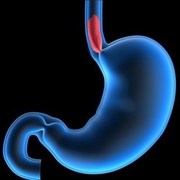Dateline: March 24, 2011. It is now six days since I had my surgery to stop the acid in my stomach from building back up into my esophagus. For the past few years, I have struggled with gastroesophageal reflux disease (GERD) and Barrett’s esophagus. Over the course of the past year, my symptoms became increasingly worse so no matter what I ate, I felt some level of discomfort, some days less tolerable than others.
After my annual endoscopy in February 2011, I asked my doctor for a referral to a surgeon who could possibly perform a surgical technique to give me some relief. She referred me to Dr. Craig Anderson of Midwest Surgical Associates, Inc. in my hometown of greater Kansas City. Since all of the prescribed medications I had taken over the years were not offering me any relief whatsoever, I felt that this was my only option. I did not want to spend my life feeling miserable, knowing that the only time I felt 100 percent was when I simply did not eat. Definitely not an option. Besides, I had been told by numerous individuals that Anderson is the leading “guru” in this procedure and that nearly all of his patients had realized positive results.
After meeting with the surgeon, he described to me a procedure, developed in the 1950s but perfected in the last decade, called fundoplication surgery. During this procedure, the upper curve of the stomach, known as the fundus, is wrapped around the esophagus and sewn into place so that the lower portion of the esophagus passes through a small tunnel of the stomach muscle. The intention of this surgery is to strengthen the valve between the esophagus and the stomach so that the stomach acid does not make its way back up into the esophagus easily. This then gives the esophagus time to heal. During my procedure, Anderson also repaired my hiatal hernia.
Anderson was very precise in his description of the procedure and also referred me to a few videos on YouTube that detail the surgery, one of which can be found at http://www.youtube.com/watch?v=n4WuM9rc-ZY. Even though I can present with a queasy stomach under such opportunities, I did find it very fascinating.
I was informed that the entire procedure would last about 90 minutes, and more if it was determined that my gall bladder had to be removed, because in some cases a gall bladder that does not function properly and/or produces gallstones can be a contributing factor in esophageal disease.
During the week prior to my surgery, I underwent a few diagnostic exams, such as a gastro emptying scan to see if the contents of my stomach emptied properly (which they did), a gall bladder sonogram to check for gallstones (I had none), and a hepatobiliary scan, also known as a PIPIDA scan, which shows through nuclear medicine technology how my gall bladder functions. Fortunately in my case, my gall bladder was not the culprit, so it still happily remains inside my body as of today!
Armed with more than enough information for my personal needs – thanks to the internet and a wise physician – and with the knowledge that my gall bladder would remain intact, I arrived at the hospital the morning of the procedure calm and relaxed. I was simply excited to know that eating would potentially no longer be torture. Additionally, it has been reported that those who undergo the surgery are less likely to need medicine on a daily basis and have less severe symptoms when they stop taking medicine.
However, as with any medical procedure, there are some inherent risks. For example, about two out of 10 people who have the surgery may develop new problems, such as difficulty swallowing, an increase in intestinal gas, or bloating. These particular symptoms may or may not respond to medicinal treatments.
In some cases, the patient may have difficulty swallowing after the surgery because the stomach has been warped too high on the esophagus or has been wrapped too tightly. This particular complication is more likely in those who underwent the laparoscopic technique.
There is also the risk that the heartburn will return, that the esophagus may slide out of the wrapped segment of the stomach, leaving the valve unsupported, and that the patient may experience excessive gas and/or bloating. Burping may be difficult or even impossible. Conversely, the patient may experience excessive belching for a period of time post-surgery. I jokingly noted to the doctor that should I develop excess gas and belching problems, no one in my household would even notice, as I have three teenage sons!
Anderson did point out an interesting statistic to me: that roughly three percent of individuals who undergo this procedure are subsequently not able to ever vomit again. When I inquired of him how this would interfere with an occasional bout of the stomach flu, he replied, “Well, you would just be very miserable for a few days.”
In the days since my operation, I have noticed slight pain and discomfort, the bulk of which presented in the first two days after the surgery. I had five tiny incisions near my abdomen which required optimum time to heal and are barely noticeable as of today. While most patients may stay in the hospital for a night or two, I was released just seven hours after my surgery. By seven that evening, I was actually taking a two-mile walk with my husband. My doctor encouraged me to do some light walking to relieve the build-up of gas that was produced by some air they had to pump into me during the operation.
In the week following the procedure, my normal work routine was barely disturbed. I felt moderate discomfort for a few days. I have had to maintain a liquid and/or soft foods diet, but I am confident that the results will be in my favor. I am glad that I took the opportunity to do this. While the surgery is not designed to eliminate the condition of Barrett’s esophagus, the related symptoms seem to have taken a hike. Just to be able to lie on my side in bed is pure heaven. Oh, the things we take for granted when we are healthy!
It has only been one week since my procedure, so I cannot accurately convey the long-term effects as of now. The one benefit I have noticed is that the limited diet has done wonders for the waistline. Just another benefit of this surgery!
(Some information for this article was found at http://www.webmd.com/heartburn-gerd/fundoplication-surgery-for-gastroesophageal-reflux-disease-gerd)






Add a Comment1 Comments
For the past 33 years, I have looked in the mirror every morning and asked myself: 'If today were the last day of my life, would I want to do what I am about to do today?' And whenever the answer has been 'No' for too many days in a row, I know I need to change something.
August 18, 2015 - 12:11pmstilnox online
This Comment